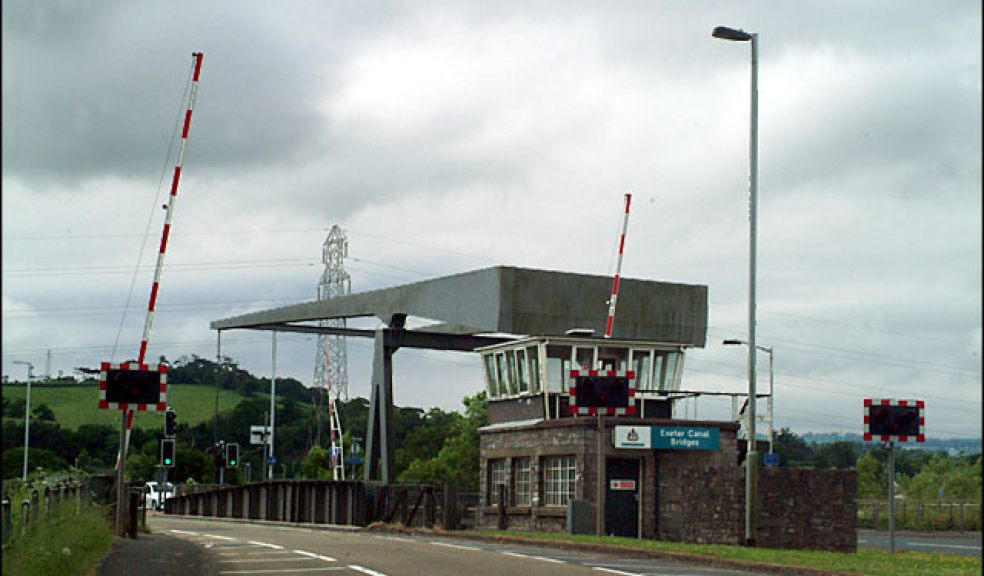
The changing face of Bridge Road in Exeter
To coincide with the fly-through footage of Bridge Road in Exeter, Devon County Council takes a look back at how the route has developed over the years.
The widening improvements are the latest chapter in the history of this busy commuter route into the city.
The road and structures along the route have evolved to cope with changes in demand, and increasing traffic levels.
Across the county, Devon County Council maintains over 3,000 bridges. More than 50 of these are along the course of the River Exe alone and some of the key crossings are on Bridge Road. With so many structures involved in the widening scheme it is no surprise the scheme is far from straight forward.
A brief look at some of those changes over time:
Countess Wear Bridge
In 1286 the Countess of Devon, Isabella de Fortibus, made it possible for a weir to be constructed over the Exe, thereby giving the name of Countess Wear to the nearby village and the subsequent bridge built centuries later.
The Countess Wear Bridge itself was originally constructed by Thomas Parker of Topsham, at the expense of the Exeter Turnpike Trust. Work started in March 1771 and was completed in September 1774. It originally consisted of seven spans ranging from 23ft to 26ft, and was wide enough for one vehicle. It was built on the site of a previous ford which was “frequently dangerous” and had claimed several lives. Triangular refuges in the parapet wall above each cutwater allowed pedestrians to move out of the way of horse drawn traffic. The bridge was constructed with a mixture of local red sandstone and limestone.
In 1842, one of the middle piers was removed and the central arches were replaced by a 60ft span arch by Thomas Whitaker, on behalf of Robert Davy who had an interest in the nearby paper mills.
The bridge was widened downstream between 1935 and 1938 using reinforced concrete and masonry facing, as part of the construction of the Exeter bypass, which opened in February 1938.
The Countess Wear Bridge has been Grade II Listed since 2004 and Listed Building Consent was granted in 2014 for the new pedestrian and cycle bridge which will eventually be attached onto the bridge as part of the widening scheme.
The design of this new bridge is linked to the current and past forms of Countess Wear Bridge, and this was key in the application for Listed Building Consent. A notable design feature of the new bridge is the inclusion of five triangular refuges in the new stainless steel parapet, which will echo the historic form of the bridge while also providing places for pedestrians to stop and enjoy the view. The weathering steel fascia panels on the new bridge have been selected to complement the colour and texture of the red sandstone in the historic bridge.
Reinforced concrete piled foundations were carefully installed in the piers of the bridge in 2014, in preparation for the cantilever beam supports which will be hidden inside the deck of the new bridge. The new bridge has been designed using modern materials to appear lightweight and “gravity defying” so that it obscures as little of the old structure as possible. The new bridge has been designed for a 120 year lifespan.
Exeter Canal Swing Bridge
Although there was a bridge across the canal from at least 1821, the existing Swing Bridge structure dates from 1936.
Most famously, in May 1944, it was used in the preparations for the D-Day campaign as a rehearsal for the glider attack on the Pegasus and Horsa Bridges by the Second Battalion Oxfordshire and Buckinghamshire Light Infantry, which took place a month later.
A plaque detailing its significance was unveiled at the bridge on 20 July 1994.
The Canal bridges were given a £2.5 million refurbishment from September 2006 to May 2007 when most of the original mechanical and electrical equipment was changed, the bridge deck was reinforced with steel and 1,000 rivets were replaced.
The structure will undergo a complex move as part of the upgrade work, as it will be rotated by around a metre to improve its alignment to accommodate two lanes to Matford roundabout. Although this may seem like a minor change in terms of location, it will require precision work in tight spaces to install new piled foundations to support the bridge in its new position, along with careful reconfiguration of the control systems.
Exeter Canal Bascule Bridge
The Bascule Bridge was built in 1972 by a Sheffield company. Aluminium was used in the construction of the bridge deck to reduce its weight – the lifting section measures just over 17 metres.
The mechanical equipment on the Bascule Bridge was completely overhauled as part of the 2006/2007 refurbishment. As the bridges are located next to the Exe Estuary, which is a Site of Special Scientific Interest and a RAMSAR wetland conservation area, both bridges had to be fully enclosed when they were repainted to ensure it did not contaminate the surrounding area.
Railway overbridge
The existing railway overbridge, which is a nine metre single span structure, was constructed in 1935/36. It has ten riveted steel plate girders with concrete infill. A new pedestrian and cycle bridge will be built over the railway line to the north side of the existing bridge. The new steel truss footbridge will span 24 metres between two reinforced concrete abutments. Pedestrians and cyclists will access the footbridge from approach ramps supported partly by reinforced concrete retaining walls on piled foundations.
Flood relief structures
These reinforced concrete structures were both built following the flooding in Exeter in 1960. The Countess Wear Flood Relief bridge, a 39 metre, five span structure, was built in 1965.
The Exe Channel Flood Relief, a 24 metre long, three span structure, was built in 1967. The east side of the Countess Wear Flood Relief structure is currently being removed and rebuilt to accommodate the widened road alignment.
The west side will be removed and extended between late May and October. This will involve “hydrodemolition”, where the existing concrete is removed using high pressure water jets, leaving the steel reinforcement intact. New steel reinforcement will then be introduced and new concrete poured to encase both the old and new reinforcement.
For more information or to subscribe to regular updates visit https://new.devon.gov.uk/bridgeroad/
Related article: http://www.theexeterdaily.co.uk/news/business-daily-local-news/fly-throu...
Image: © Copyright Mike Crowe and licensed for reuse under this Creative Commons Licence.

















